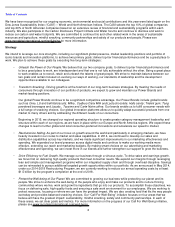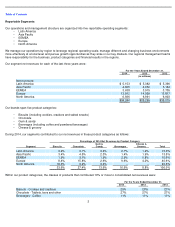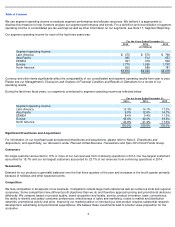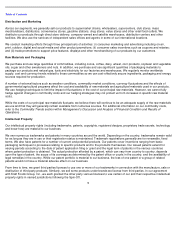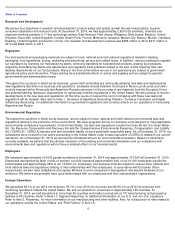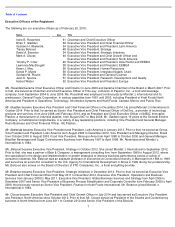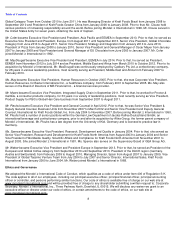Mondelez 2014 Annual Report Download - page 15
Download and view the complete annual report
Please find page 15 of the 2014 Mondelez annual report below. You can navigate through the pages in the report by either clicking on the pages listed below, or by using the keyword search tool below to find specific information within the annual report.
Table of Contents
productivity or adapt to changing conditions. Although we monitor our exposure to commodity prices and hedge against input price
increases, we cannot fully hedge against changes in commodity costs, and our hedging strategies may not protect us from
increases in specific raw material costs. Continued volatility in the prices of commodities and other supplies we purchase could
increase or decrease the costs of our products, and our profitability could suffer as a result. Moreover, increases in the price of our
products to cover increased input costs may result in lower sales volumes, while decreases in input costs could require us to lower
our prices and thereby affect our revenues, profits or margins. Likewise, constraints in the supply of key commodities may limit our
ability to grow our net revenues. If our mitigation activities are not effective, if we are unable to price to cover increased costs or
must reduce our prices, or if we are limited by supply constraints, our financial condition and results of operations could be
materially adversely affected.
Changes in laws and regulations could increase our costs.
Our activities throughout the world are highly regulated and subject to government oversight. Various laws and regulations govern
food production, storage, distribution, sales, advertising and marketing, as well as licensing, trade, labor, tax and environmental
matters, and health and safety practices. Government authorities regularly change laws and regulations and their interpretations.
Our compliance with new or revised laws and regulations or the interpretation and application of existing laws and regulations could
materially and adversely affect our product sales, financial condition and results of operations.
We may be unable to hire or retain and develop key personnel or a highly skilled and diverse global workforce or manage
changes in our workforce.
We must hire, retain and develop effective leaders and a highly skilled and diverse global workforce. We compete to hire new
personnel in the many countries in which we manufacture and market our products and then to develop and retain their skills and
competencies. Unplanned turnover or failure to develop adequate succession plans for leadership positions or hire and retain a
diverse global workforce with the skills and in the locations we need to operate and grow our business could deplete our
institutional knowledge base and erode our competitiveness.
We also face increased personnel-related risks in connection with implementing the changes in our transformation agenda related
to our operating model and business processes. These risks could lead to operational challenges, including increased competition
for employees with the skills we require to achieve our business goals, higher employee turnover, including of employees with key
capabilities, and challenges in developing the capabilities necessary to transform our business processes. Furthermore, we might
be unable to manage changes in, or that affect, our workforce appropriately or satisfy the legal requirements associated with how
we manage and compensate our employees. This includes our management of employees represented by labor unions or workers
’
councils, who represent approximately 64% of our 91,000 employees outside the United States and approximately 28% of our
13,000 U.S. employees.
These risks could materially and adversely affect our reputation, ability to meet the needs of our customers, product sales, financial
condition and results of operations.
We must address risks related to consolidation of retail customers and leverage our value proposition in order to compete
against retailer and other economy brands.
Retail customers, such as supermarkets, warehouse clubs and food distributors in the European Union, the United States and our
other major markets, continue to consolidate, resulting in fewer but larger customers with whom we can conduct business. Larger,
more sophisticated retail customers and alliances among customers can resist price increases, delist or reduce the shelf space
allotted to our products, and demand lower pricing, increased promotional programs, longer payment terms or specifically tailored
products. In addition, larger retail customers have the scale to develop supply chains that permit them to operate with reduced
inventories or to develop and market their own retailer and other economy brands that compete with some of our products. Our
products must provide higher quality or value to our consumers than the less expensive alternatives, particularly during periods of
economic uncertainty. Consumers may not buy our products if consumers perceive the difference in the quality or value between
our products and retailer or other economy brands has narrowed. If consumers switch to purchasing or otherwise prefer retailer or
other economy brands, then we could lose market share or sales volumes or need to shift our product mix to lower margin
offerings.
Retail consolidation also increases the risk that adverse changes in our customers’ business operations or financial performance
will have a corresponding material adverse effect on us. For example, if our customers cannot access sufficient funds or financing,
then they may delay, decrease or cancel purchases of our products, or delay or fail to pay us for previous purchases.
12


